There is not a person in this country who hasn’t time and again replayed the horrible visions of September 11, 2001 in their mind.
As I’ve re-counted what I witnessed, it was the willingness of American citizens to commit selfless acts of courage to help each other in the face of astronomical odds that stands out most.
That morning, one like any other, I was at my desk inside the National Military Command Center, in the Pentagon, when I heard about the first World Trade Center tower. I remember watching on television the second aircraft crash into the remaining World Trade Center tower a few moments later. Clearly, this was no ordinary aircraft accident.
Within minutes, there were reports of another airliner crash on the north-south running freeway south of the Pentagon. I must admit my first thoughts were of my wife, Candy, who worked in a building at the intersection of this freeway and the Capital Beltway. I immediately called her and told he to go home and stay off the interstate.
Within seconds, the notification came that the crash on the “highway” was actually into the West side of the Pentagon, and all were ordered to evacuate. After checking in with my Commander, I made sure the Division’s offices were empty.
Smoke and fumes filled the North East part of the building quickly. By the time I evacuated, you could smell jet fuel from the aircraft and the foul odor of a sixty-year-old building burning ferociously. Exiting at the River Entrance on the second floor right next to the Chairman of the Joint Chief’s Office, I looked back to check the damage and observed dense black smoke billowing above and blowing toward the southeast.
Arriving at the evacuation rally point, I saw a small area that had been set up by two medics and a single doctor. This was a central place to take and treat wounded if any came out the northeast exit. A small group of Pentagon workers were assisting them. These volunteers helped the wounded whose injuries ranged from multiple broken bones and breathing problems to third degree burns over large parts of their bodies.
Word arrived of another inbound aircraft, and organized chaos became total chaos when we realized there were nearly 23,000 people standing in the open visible from the air. The crowd quickly dispersed to areas further away from the building. I remember seeing some Pentagon day care center workers calmly leading the children in their charge away and how out of place they seemed against a backdrop of enormous flames and smoke from the crash site.
I had reached the Corridor 8 entrance and began directing casualties down to the bottom of the hill where medics had set up a triage area. At first the casualties were walking wounded (about 5 or 6 of them), but then folks started coming out being carried and on stretchers in pretty bad shape (burns, both legs broken, trouble breathing types of injuries).
I left my post to help assist a Navy Petty Officer (PO) down to the medics’ area. I soon realized there were no ambulances or medevac helicopters to be seen, even though all hell was breaking loose and the medics appeared to be getting overwhelmed.
The Army Officer’s IV line was broken.
We started getting warnings of another air attack. The large crowd of evacuees split in two and headed for the overpasses as we continued working the causalities. In these moments, things got really confusing. Volunteers were still carrying injured victims out, unaware of the possibility of another attack but in need of a medevac.
I continued to help move patients across the road and dispensing hazardous material until a couple of ambulances finally showed up and started loading patients.
Ambulances and helicopters began to arrive. A call came for volunteers to re-enter the Pentagon to help rescue more survivors. There was no hesitation from those that responded. Teams were formed; names were recorded on a piece of paper that was passed around in case the worst happened. Makeshift breathing masks were made with wet shirts as these men and women went back into the burning Pentagon. The acrid smoke was so thick you couldn’t see beyond more than a few feet.
These teams worked throughout the day from inside the Pentagon courtyard attempting to rescue the wounded, even as the intense fire and heat repeatedly pushed them back. Some worked their way to the crash site where American Flight 77’s cockpit had burst through its final wall.
Debris and fire spewed into the alleyway between two of the Pentagon rings. Eventually the point was reached where the mission was forced to change from one of rescue to one of assisting the fire fighting, engineering, and FBI teams that were trying to save the building and preserve the crash site for investigation.
This group of volunteers was remarkable beyond description. They were not simply civilian and military men and women with rank or status… they were Americans, all working equally in a common cause. They faced unknown dangers with unlimited courage. Without hesitation, they asked no questions as they comforted and cared for the injured.
In the best of the American tradition of selfless sacrifice they saw that action was needed… and responded.
Col. Rob Maness (USAF-ret.) served 32 years in the United States Air Force and was in the Pentagon on September 11, 2001.

COMMENTS
Please let us know if you're having issues with commenting.